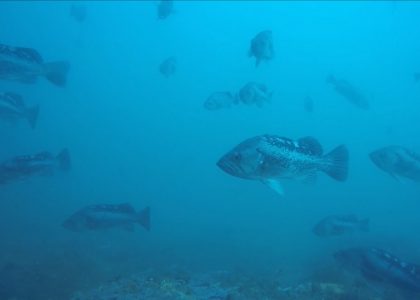The Otter Rock Marine Reserve is located off the central Oregon coast, near the unincorporated town of Otter Rock. This is Oregon’s smallest marine reserve at 1.2 square miles.

Marine Reserve
No take of animals or seaweeds. No ocean development.
What Makes Otter Rock Unique

Beneath the Surface
At the north end of the marine reserve you’ll find extensive rocky intertidal habitats along the shore. Rocky intertidal habitats are in the intertidal zone, a narrow band of shoreline that is covered by water during high tides and then exposed at low tides. Common species include mussels, sea stars, sea anemones, chitons, and a wide variety of seaweeds. Underwater, the reserve includes a shallow rocky reef, kelp beds, soft bottom habitats, and sand dollar beds.
From Land
The Otter Rock Marine Reserve can be accessed through the Devils Punchbowl State Natural Area. In and around the site visitors can explore tidepools, view seals hauled out onto the rocks, and stroll along the long sandy beach at Beverly Beach State Park. Check out tips on tidepool etiquette and viewing seals to help protect these species and special places. Three offshore islands mark the west boundary of the marine reserve. Nearby towns and ports include Depoe Bay, Otter Rock, and Newport.
Planning a Visit?
For more Otter Rock activities, including hikes and viewpoints, visit this activity guide to plan your trip.
| Harvest Restrictions Began | January 1, 2012 |
| Monitoring Began | 2010 |
| Size | Reserve: 3 sq km (1.2 sq mi) |
| Depth Range | 0-18 m (0-59 ft) |
| Habitats | Emergent rocks, bedrock and boulders, patches of kelp beds, areas of soft bottom, and sand dollar beds. Rocky intertidal habitats. |
| Habitat Connectivity | Rocky habitats extend beyond the reserve. |
| Prior Fishing Pressure | Relatively low due to limited rocky reef and shallow depths. |
| Monitoring Comparison Area | Cape Foulweather |
Design & Placement Matter
The ODFW Marine Reserves Program uses different monitoring tools tailored to each of Oregon’s marine reserves based on the reserve’s size, habitats, depths, prior fishing activities, and other unique characteristics of each reserve.
The Otter Rock Marine Reserve is a small — 1.2 sq mile — reserve found in shallow waters, less than 50 ft deep, with limited subtidal rock habitat. These characteristics along with the relatively low fishing pressure that occurred at the site prior to closure means we will likely not see changes as a direct result from marine reserve protections — no fishing — in the reserve compared to areas still open to fishing.
Sampling Approach Although we anticipate minimal changes in the reserve compared to areas that are still fished, this is an important site for long-term data collection. We are sampling inside the reserve and outside the reserve — at Cape Foulweather — to look at changes to the marine communities through time. Long-term monitoring sites and data sets help us track and understand changes occurring in Oregon’s nearshore ocean environment. Understanding these changes is helpful information that can be used by marine resource managers.
Scientific Training Ground This site provides local scientists with a perfect training ground to try out new approaches, hone skills, and learn more about nearshore ocean ecosystems in general. Volunteer scientific divers train in this area, our staff conducts pilot studies to help with methods refinement here, and Oregon State University scientists conduct juvenile fish settlement studies in this reserve.

























